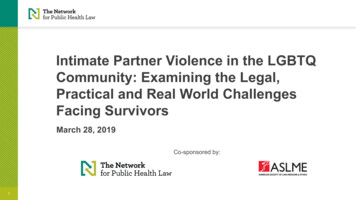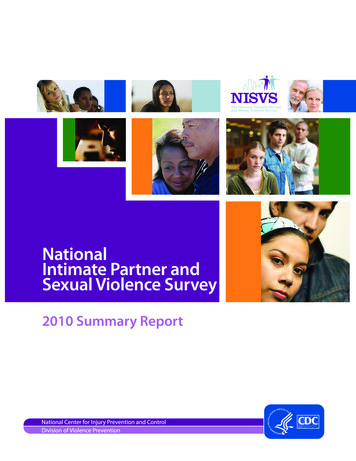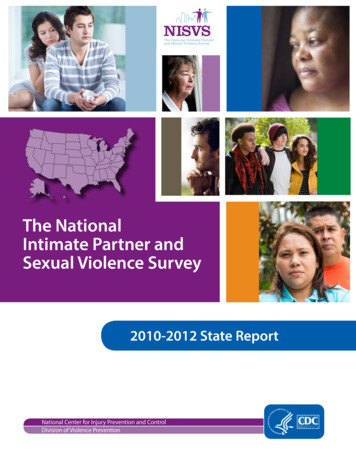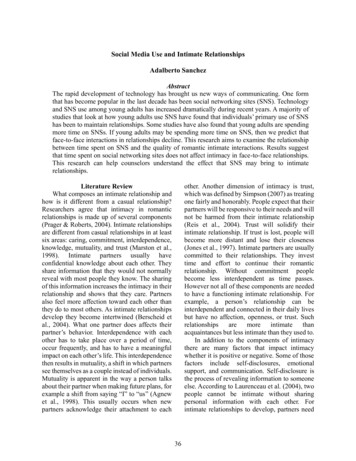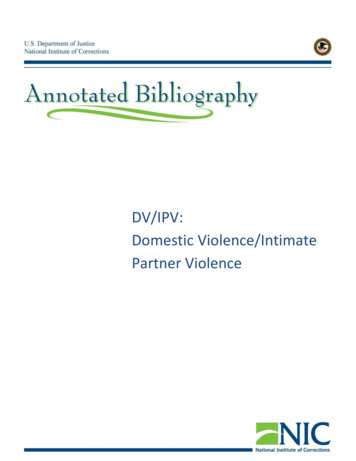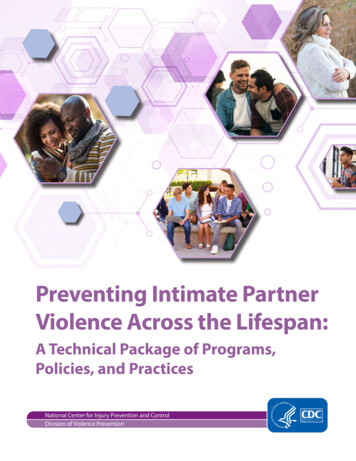
Transcription
Preventing Intimate PartnerViolence Across the Lifespan:A Technical Package of Programs,Policies, and PracticesNational Center for Injury Prevention and ControlDivision of Violence Prevention
Preventing Intimate Partner ViolenceAcross the Lifespan: A Technical Package ofPrograms, Policies, and PracticesDeveloped by:Phyllis Holditch Niolon, PhDMegan Kearns, PhDJenny Dills, MPHKirsten Rambo, PhDShalon Irving, PhDTheresa L. Armstead, PhDLeah Gilbert, PhD2017Division of Violence PreventionNational Center for Injury Prevention and ControlCenters for Disease Control and PreventionAtlanta, GeorgiaPreventing Intimate Partner Violence Across the Lifespan: A Technical Package of Programs, Policies, and Practices1
Centers for Disease Control and PreventionAnne Schuchat, MD (RADM, USPHS), Acting DirectorNational Center for Injury Prevention and ControlDebra E. Houry, MD, MPH, DirectorDivision of Violence PreventionJames A. Mercy, PhD, DirectorSuggested citation:Niolon, P. H., Kearns, M., Dills, J., Rambo, K., Irving, S., Armstead, T., & Gilbert, L. (2017).Preventing Intimate Partner Violence Across the Lifespan: A Technical Package of Programs,Policies, and Practices. Atlanta, GA: National Center for Injury Prevention and Control,Centers for Disease Control and Prevention.2Preventing Intimate Partner Violence Across the Lifespan: A Technical Package of Programs, Policies, and Practices
ContentsAcknowledgements. 5External Reviewers. 5Overview. 7Teach Safe and Healthy Relationship Skills.15Engage Influential Adults and Peers.19Disrupt the Developmental Pathways Toward Partner Violence.23Create Protective Environments.29Strengthen Economic Supports for Families .33Support Survivors to Increase Safety and Lessen Harms .37Sector Involvement.43Monitoring and Evaluation.45Conclusion.46References .47Appendix: Summary of Strategies.58Preventing Intimate Partner Violence Across the Lifespan: A Technical Package of Programs, Policies, and Practices3
AcknowledgementsWe would like to thank the following individuals who contributed in specific ways to the development of this technicalpackage. We give special thanks to Linda Dahlberg for her vision, guidance, and support throughout the developmentof this package. We thank Division, Center, and CDC leadership for their careful review and helpful feedback on earlieriterations of this document. We thank Alida Knuth for her formatting and design expertise. We also extend our thanksand gratitude to all the external reviewers for their helpful feedback, support and encouragement for this resource.We dedicate this document to the memory of our co-author, Shalon M. Irving, who passed away during thedevelopment of this publication. We are grateful for the time we shared with Shalon working on this publication. “Dr.Shalon”, as she was affectionately known, worked tirelessly to improve community health outcomes and brought joyto everyone who knew her. Her efforts to prevent violence and toward improving health equity at the CDC and acrossthe U.S. are part of her legacy.External ReviewersCasey CastaldiPrevention InstituteAshleigh Klein JimenezCalifornia Coalition Against Sexual AssaultAmalia Corby-EdwardsAmerican Psychological AssociationDavid S. LeeCalifornia Coalition Against Sexual AssaultDiane Fields-JohnsonPrevention InstituteAnne MenardNational Resource Center on Domestic ViolenceLisa Fujie ParksPrevention InstituteBethany D. MillerMaternal and Child Health Bureau,Health Resources and Services AdministrationJennifer GroveNational Sexual Violence Resource CenterDan HartleyNational Institute for Occupational Safety and Health,Centers for Disease Control and PreventionLisa JamesFutures Without ViolenceMarylouise KellyFamily Violence Prevention and Services Program,Administration for Children and FamiliesCarrie MulfordNational Institute of JusticeRebecca K. OdorFamily Violence Prevention and Services Program,Administration for Children and FamiliesAlisha SomjiPrevention InstituteThe experts above are listed with their affiliations at the time this document was reviewed.Preventing Intimate Partner Violence Across the Lifespan: A Technical Package of Programs, Policies, and Practices5
OverviewThis technical package represents a select group of strategies based on the best available evidence to helpcommunities and states sharpen their focus on prevention activities with the greatest potential to prevent intimatepartner violence (IPV) and its consequences across the lifespan. These strategies include teaching safe and healthyrelationship skills; engaging influential adults and peers; disrupting the developmental pathways toward IPV; creatingprotective environments; strengthening economic supports for families; and supporting survivors to increase safetyand lessen harms. The strategies represented in this package include those with a focus on preventing IPV, includingteen dating violence (TDV), from happening in the first place or to prevent it from continuing, as well as approachesto lessen the immediate and long-term harms of partner violence. Commitment, cooperation, and leadership fromnumerous sectors, including public health, education, justice, health care, social services, business and labor, andgovernment can bring about the successful implementation of this package.What is a Technical Package?A technical package is a compilation of a core set of strategies to achieve and sustain substantial reductions in aspecific risk factor or outcome.1 Technical packages help communities and states prioritize prevention activities basedon the best available evidence. This technical package has three components. The first component is the strategy orthe preventive direction or actions to achieve the goal of preventing IPV/TDV. The second component is the approach.The approach includes the specific ways to advance the strategy. This can be accomplished through programs, policies,and practices. The evidence for each of the approaches in preventing IPV or TDV and/or associated risk factors isincluded as the third component. This package is intended as a resource to guide and inform prevention decisionmaking in communities and states.Preventing Intimate Partner Violence is a PriorityIPV is a serious preventable public health problem that affects millions of Americans and occurs across the lifespan.2-4 Itcan start as soon as people start dating or having intimate relationships, often in adolescence. IPV that happens whenindividuals first begin dating, usually in their teen years, is often referred to as TDV. From here forward in this technicalpackage, we will use the term IPV broadly to refer to this type of violence as it occurs across the lifespan. However,when outcomes are specific to TDV, we will note that.IPV (also commonly referred to as domestic violence) includes “physical violence, sexual violence, stalking, andpsychological aggression (including coercive tactics) by a current or former intimate partner (i.e., spouse, boyfriend/girlfriend, dating partner, or ongoing sexual partner).”5 Some forms of IPV (e.g., aspects of sexual violence,psychological aggression, including coercive tactics, and stalking) can be perpetrated electronically through mobiledevices and social media sites, as well as, in person. IPV happens in all types of intimate relationships, includingheterosexual relationships and relationships among sexual minority populations. Family violence is another commonlyused term in prevention efforts. While the term domestic violence encompasses the same behaviors and dynamics asIPV, the term family violence is broader and refers to a range of violence that can occur in families, including IPV, childabuse, and elder abuse by caregivers and others. This package is focused on IPV across the lifespan, including partnerviolence among older adult populations. The Centers for Disease Control and Prevention (CDC) has developed aseparate technical package for the prevention of child abuse and neglect.6IPV is highly prevalent. IPV affects millions of people in the United States each year. Data from the National IntimatePartner and Sexual Violence Survey (NISVS) indicate that nearly 1 in 4 adult women (23%) and approximately 1 in7 men (14%) in the U.S. report having experienced severe physical violence (e.g., being kicked, beaten, choked, orburned on purpose, having a weapon used against them, etc.) from an intimate partner in their lifetime. Additionally,16% of women and 7% of men have experienced contact sexual violence (this includes rape, being made to penetratePreventing Intimate Partner Violence Across the Lifespan: A Technical Package of Programs, Policies, and Practices7
someone else, sexual coercion, and/or unwanted sexual contact) from an intimate partner. Ten percent of women and2% of men in the U.S. report having been stalked by an intimate partner, and nearly half of all women (47%) and men(47%) have experienced psychological aggression, such as humiliating or controlling behaviors.3The burden of IPV is not shared equally across all groups; many racial/ethnic and sexual minority groups aredisproportionately affected by IPV. Data from NISVS indicate that the lifetime prevalence of experiencing contactsexual violence, physical violence, or stalking by an intimate partner is 57% among multi-racial women, 48% amongAmerican Indian/Alaska Native women, 45% among non-Hispanic Black women, 37% among non-Hispanic Whitewomen, 34% among Hispanic women, and 18% among Asian-Pacific Islander women. The lifetime prevalence is42% among multi-racial men, 41% among American Indian/Alaska Native men, 40% among non-Hispanic Blackmen, 30% among non-Hispanic White men, 30% among Hispanic men, and 14% among Asian-Pacific Islander men.3Additionally, the NISVS special report on victimization by sexual orientation demonstrates that some sexual minoritiesare also disproportionately affected by IPV victimization; 61% of bisexual women, 37% of bisexual men, 44% of lesbianwomen, 26% of gay men, 35% of heterosexual women, and 29% of heterosexual men experienced rape, physicalviolence, and/or stalking from an intimate partner in their lifetimes.7 In regards to people living with disabilities, onestudy using a nationally representative sample found that 4.3% of people with physical health impairments and 6.5%of people with mental health impairments reported IPV victimization in the past year.8 Studies also show that peoplewith a disability have nearly double the lifetime risk of IPV victimization.9IPV starts early in the lifespan. Data from NISVS demonstrate that IPV often begins in adolescence. An estimated 8.5million women in the U.S. (7%) and over 4 million men (4%) reported experiencing physical violence, rape (or beingmade to penetrate someone else), or stalking from an intimate partner in their lifetime and indicated that they firstexperienced these or other forms of violence by that partner before the age of 18.3 A nationally representative surveyof U.S. high school students also indicates high levels of TDV. Findings from the 2015 Youth Risk Behavior Surveyindicate that among students who reported dating, 10% had experienced physical dating violence and a similarpercentage (11%) had experienced sexual dating violence in the past 12 months.10 In an analysis of the 2013 surveywhere the authors examined students reporting physical and/or sexual dating violence, the findings indicate thatamong students who had dated in the past year, 21% of girls and 10% of boys reported either physical violence, sexualviolence, or both forms of violence from a dating partner.11 While the YRBS does not provide national data on theprevalence of stalking victimization among high school students, we know from NISVS that nearly 3.5 million women(3%) and 900,000 men (1%) in the U.S. report that they first experienced stalking victimization before age 18.3 A studyconducted in Kentucky suggests that nearly 17% of high school students in that state report stalking victimization,with most students indicating that they were most afraid of a former boyfriend or girlfriend as the stalker.12 Researchalso indicates that IPV is most prevalent in adolescence and young adulthood and then begins to decline with age,2demonstrating the critical importance of early prevention efforts.IPV is associated with several risk and protective factors. Research indicates a number of factors increase risk forperpetration and victimization of IPV. The risk and protective factors discussed here focus on risk for IPV perpetration,although many of the same risk factors are also relevant for victimization.13-14 Factors that put individuals at risk forperpetrating IPV include (but are not limited to) demographic factors such as age (adolescence and young adulthood),low income, low educational attainment, and unemployment; childhood history factors such as exposure to violencebetween parents, experiencing poor parenting, and experiencing child abuse and neglect, including sexual violence.Other individual factors that put people at risk for perpetrating IPV include factors such as stress, anxiety, and antisocialpersonality traits; attitudinal risk factors, such as attitudes condoning violence in relationships and belief in strict genderroles; and other behavioral risk factors such as prior perpetration and victimization of IPV or other forms of aggression,such as peer violence, a history of substance abuse, a history of delinquency, and hostile communication styles.13-16Relationship level factors include hostility or conflict in the relationship, separation/ending of the relationship (e.g.,break-ups, divorce/separation), aversive family communication and relationships, and having friends who perpetrate/experience IPV.15-16 Although less studied than factors at other levels of the social ecology, community or societal levelfactors include poverty, low social capital, low collective efficacy in neighborhoods (e.g., low willingness of neighbors8Preventing Intimate Partner Violence Across the Lifespan: A Technical Package of Programs, Policies, and Practices
Researchindicates thatIPV is most prevalentin adolescence and youngadulthood and thenbegins to decline with age,demonstrating the criticalimportance of earlyprevention efforts.to intervene when they see violence), and harmful gender norms in societies (i.e., beliefs and expectations about theroles and behavior of men and women).16-17Additionally, a few protective factors have been identified that are associated with lower chances of perpetrating orexperiencing TDV. These include high empathy, good grades, high verbal IQ, a positive relationship with one’s mother,and attachment to school.15 Less is known about protective factors at the community and societal level, but researchis emerging indicating that environmental factors such as lower alcohol outlet density18 and community norms thatare intolerant of IPV19 may be protective against IPV. Although more research is needed, there is some evidencesuggesting that increased economic opportunity and housing security may also be protective against IPV.20-22IPV is connected to other forms of violence. Experience with many other forms of violence puts people at riskfor perpetrating and experiencing IPV. Children who are exposed to IPV between their parents or caregivers aremore likely to perpetrate or experience IPV, as are individuals who experience abuse and neglect as children.13,15,23Additionally, adolescents who engage in bullying or peer violence are more likely to perpetrate IPV.15,24 Those whoexperience sexual violence and emotional abuse are more likely to be victims of physical IPV.14 Research also suggestsIPV may increase risk for suicide. Both boys and girls who experience TDV are at greater risk for suicidal ideation.25-26Women exposed to partner violence are nearly 5 times more likely to attempt suicide as women not exposed topartner violence.27 Intimate partner problems, which includes IPV, were also found to be a precipitating factor forsuicide among men in a review of violent death records from 7 U.S. states.28 Research also shows that experience withIPV (either perpetration or victimization) puts people at higher risk for experiencing IPV in the future.4,13-14The different forms of violence often share the same individual, relationship, community, and societal risk factors.29The interconnections between the different forms of violence suggests multiple opportunities for prevention.30 Manyof the strategies included in this technical package include example programs and policies that have demonstratedimpacts on other forms of violence as reflected in CDC’s other technical packages for prevention of child abuse andneglect, sexual violence, youth violence and suicide.6,31-33 Recognizing and addressing the interconnections among thedifferent forms of violence will help us better prevent all forms of violence.Preventing Intimate Partner Violence Across the Lifespan: A Technical Package of Programs, Policies, and Practices9
The health and economic consequences of IPV are substantial. Approximately 41% of female IPV survivors and14% of male IPV survivors experience some form of physical injury related to their experience of relationship violence.2IPV can also extend beyond physical injury and result in death. Data from U.S. crime reports suggest that 16% (about1 in 6) of murder victims are killed by an intimate partner, and that over 40% of female homicide victims in the U.S.are killed by an intimate partner.34 There are also many other adverse health outcomes associated with IPV, includinga range of cardiovascular, gastrointestinal, reproductive, musculoskeletal, and nervous system conditions, many ofwhich are chronic in nature.35 Survivors of IPV also experience mental health consequences, such as depression andposttraumatic stress disorder (PTSD).36 Population-based surveys suggest that 52% of women and 17% of men whohave experienced contact sexual violence, physical violence or stalking by an intimate partner report symptoms ofPTSD related to their experience of relationship violence.3 IPV survivors are also at higher risk for engaging in healthrisk behaviors, such as smoking, binge drinking, and HIV risk behaviors.37A substantial proportion of survivors also report other negativeimpacts as a result of IPV, and there is wide variation in the proportionsof female and male survivors reporting these impacts. Populationbased surveys indicate that among women and men in the U.S.who have experienced contact sexual violence, physical violence,or stalking by an intimate partner during their lifetimes, 73% of thewomen and 36% of the men report at least one measured negativeimpact related to these victimization experiences (e.g., fear, concernfor safety, missing school or work, needing services).3 Among thefemale IPV survivors, 62% reported feeling fearful, 57% reported beingconcerned for their safety, 25% missed at least one day of schoolor work from the IPV, 19% reported needing medical care, and 8%needed housing services. Among the male survivors, 18% reportedfeeling fearful, 17% reported being concerned for their safety, 14%missed at least one day of school or work from the IPV, 5% reportedneeding medical care, and 2% needed housing services.3Although the personal consequences of IPV are considerable,there are also considerable societal costs associated with medicalservices for IPV-related injury and health consequences, mentalhealth services, lost productivity from paid work, childcare, andhousehold chores, and criminal justice and child welfare costs. Theonly currently available estimates of societal costs of IPV are fromthe mid-1990s, but suggest that the annual costs even 20 years agowere estimated at 5.8 billion based on medical and mental healthservices and lost productivity alone.38IPV can be prevented. Primary prevention of IPV, including TDV, means preventing IPV before it begins. Primaryprevention strategies are key to ending partner violence in adolescence and adulthood and protecting people fromits effects. Partner violence in adolescence can be a pre-cursor or risk factor for partner violence in adulthood. Manystrategies to prevent IPV therefore see adolescence as a critical developmental period for the prevention of partnerviolence in adulthood. It is also important to assist survivors and their children and protect them from future harm.Although there is less evidence of what works to prevent IPV compared to other areas of violence, such as youthviolence or child maltreatment, a growing research base demonstrates that there are multiple strategies to preventIPV from occurring in the first place and to lessen the harms for survivors.39 Strategies are available that can benefitadolescents and adults regardless of their level of risk as well as individuals and environments at greatest risk.A comprehensive approach that simultaneously targets multiple risk and protective factors is critical to havinga broad and sustained impact on IPV. Even though more research is needed (e.g., to strengthen the evidenceaddressing community and societal level factors), we cannot let the need for further research impede efforts toeffectively prevent IPV within our communities.10Preventing Intimate Partner Violence Across the Lifespan: A Technical Package of Programs, Policies, and Practices
A comprehensiveapproach targetingmultiple risk andprotective factors iscritical to having abroad and sustainedimpact on IPV.Assessing the EvidenceThis technical package includes programs, practices, and policies with evidence of impact on victimization, perpetration, orrisk factors for IPV. To be considered for inclusion in the technical package, the program, practice, or policy selected had tomeet at least one of these criteria: a) meta-analyses or systematic reviews showing impact on IPV victimization or perpetration;b) evidence from at least one rigorous (e.g., randomized controlled trial [RCT] or quasi-experimental design) evaluationstudy that found significant preventive effects on IPV victimization or perpetration; c) meta-analyses or systematic reviewsshowing impact on risk factors for IPV victimization or perpetration, or d) evidence from at least one rigorous (e.g., RCT orquasi-experimental design) evaluation study that found significant impacts on risk factors for IPV victimization or perpetration.Finally, consideration was also given to the likelihood of achieving beneficial effects on multiple forms of violence; no evidenceof harmful effects on specific outcomes or with particular subgroups; and feasibility of implementation in a U.S. context if theprogram, policy, or practice has been evaluated in another country.Within this technical package, some approaches do not yet have research evidence demonstrating impact on rates of IPVvictimization or perpetration but instead are supported by evidence indicating impacts on risk factors for IPV (e.g., childmaltreatment, harsh parenting, attitudes accepting of violence, financial stress). In terms of the strength of the evidence,programs that have demonstrated effects on IPV outcomes (reductions in perpetration or victimization) provide a higherlevel of evidence, but the evidence base is not that strong in all areas. For instance, there has been less evaluation of certainapproaches on IPV outcomes, such as those described in the strategy to Disrupt the Developmental Pathways to Violence, andapproaches at the outer levels of the social ecology, such as economic policy and interventions addressing community-levelrisk factors. Thus, approaches in this package that have effects on risk factors reflect the developmental nature of the evidencebase and the use of the best available evidence at a given time.There is a wide range in the nature and quality of evidence among the programs, policies, or practices that fall within oneapproach or strategy. Not all programs, policies, or practices that utilize the same approach (e.g., programs to teach youngpeople skills to prevent dating violence) are equally effective – some have impact on dating violence behaviors while othersdo not, and even those that are effective may not work across all populations. Few programs have been designed for andtested with diverse populations (e.g., racial/ethnic, sexual minority, incarcerated, and immigrant populations to name a few),so tailoring programs and more evaluation may also be necessary to address different population groups. The evidence-basedprograms, practices, or policies included in the package are not intended to be a comprehensive list for each approach, butrather to serve as examples that have been shown to impact IPV victimization or perpetration or have beneficial effects on riskfactors for IPV. In practice, the effectiveness of the programs, policies and practices identified in this package will be stronglydependent on the quality of their implementation and the communities in which they are implemented. Implementationguidance to assist practitioners, organizations and communities will be developed separately.Preventing Intimate Partner Violence Across the Lifespan: A Technical Package of Programs, Policies, and Practices11
Context and Cross-Cutting ThemesThe strategies and approaches included in this technical package represent different levels of the social ecology, withefforts intended to impact individual behaviors and also the relationships, families, schools, and communities thatinfluence risk and protective factors for IPV. The strategies and approaches are intended to work in combination andreinforce each other to prevent IPV (see box below). While individual skills are important and research has demonstratedpreventive effects in reducing IPV, approaches addressing peer, family, school and other environments as well as societalfactors are equally important for a comprehensive approach that can have the greatest public health impact.Preventing IPVStrategyApproachTeach safe and healthy relationship skills Social-emotional learning programs for youth Healthy relationship programs for couplesEngage influential adults and peers Men and boys as allies in prevention Bystander empowerment and education Family-based programsDisrupt the developmental pathwaystoward partner violence Create protective environments Improve school climate and safety Improve organizational policies and workplace climate Modify the physical and social environments of neighborhoodsStrengthen economic supports forfamilies Strengthen household financial security Strengthen work-family supports Support survivors to increase safety and lessen harms 12Early childhood home visitationPreschool enrichment with family engagementParenting skill and family relationship programsTreatment for at-risk children, youth and familiesVictim-centered servicesHousing programsFirst responder and civil legal protectionsPatient-centered approachesTreatment and support for survivors of IPV, including TDVPreventing Intimate Partner Violence Across the Lifespan: A Technical Package of Programs, Policies, and Practices
While each of the strategies and approaches in the package has a particular focus, several important themes arecross-cutting and are addressed by multiple strategies. One of these is an emphasis on creating safe, stable, nurturingrelationships and environments in childhood and adolescence to prevent IPV across the lifespan. Approaches suchas social-emotional learning, early childhood home visitation, preschool enrichment, parenting skill and familyrelationship programs, and efforts to create protective environments and lessen harms are intended to addressexposures to violence, build skills, strengthen relationships, and create the context to prevent IPV across the lifespan.The strategies and approaches in this regard are intended to be complementary and have a potentially synergisticimpact. Changing social norms, including harmful gender norms, is another aspect that cross-cuts many of thestrategies in this package. Social norms supportive of violence, including harmful gender norms, are demonstratedrisk factors for IPV.13-15 Social tolerance of violence and harmful gender norms are learned in childhood and reinforcedin different peer, family, social, economic, and cultural
Preventing Intimate Partner Violence Across the Lifespan: A Technical Package of Programs, Policies, and Practices. 5. Acknowledgements. We would like to thank the following individuals who contributed in specific ways to the development of this technical


